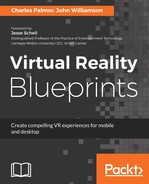In positional tracked systems (Vive, Rift, PSVR, HoloLens), be aware of the fact that users are going to be different heights. Ensure that your experience can accommodate someone who is 1 m and someone who is 2 m tall. If you are going to have the players reach for inventory items, either from a belt attached to the player, or from a table top, design accordingly so that all players can reach them.
Follow some of the old Kinect design best practices. Using your arms with a wireless controller on each hand in VR can be surprisingly fatiguing. This is especially true when the user must hold their arms at full extension. Build rest time into your experiences. Allow the users to assume different poses and relax from time to time. Keep in mind that users may have different levels of conditioning, and what may be an easy experience for a college-age developer, may be a challenging experience for older or differently abled users.
Ensure your users can be aware of their surroundings. Swinging at a virtual ghost can have them banging into a wall, TV, or another guest, damaging themselves, hardware, or others.
Render splash screens and UI in 3D space so that they can move realistically as the player expects them to. They need not be built into a helmet that they player appears to wear, as many early VR experiences used to; they can be built into the world as if in a Sci-Fi version of a smart assistant.
If you are going to use a helmet to project the UI, ensure that the UI elements render in front of everything else, but not so close that it causes extreme, stereoscopic disparity, which can quickly fatigue the user and/or lead to headaches. This may mean that your helmet is larger than it would be if it really existed. Stereoscopic 3D is an important cue for 3D space, but it is a rather weak cue and can be overpowered with most 2D cues (occlusion, perspective, and so on).
Keep in mind the display screen is just inches from the user's eyes. Any large change in brightness will be exacerbated and may cause discomfort. Rapidly flashing/flickering images in any display may cause seizures; having flickering displays that take up nearly all of a user's field of view would most likely exacerbate that issue in people who are prone to seizures already.
If it is easy to select a menu option accidentally in VR, ensure the user can quickly and efficiently back out. It is often easy to select an incorrect menu item in VR compared to the accuracy of a mouse and keyboard or game controller. Snapping the user from one input to another is one way to address this concern, as is a confirmation Yes/No screen.
